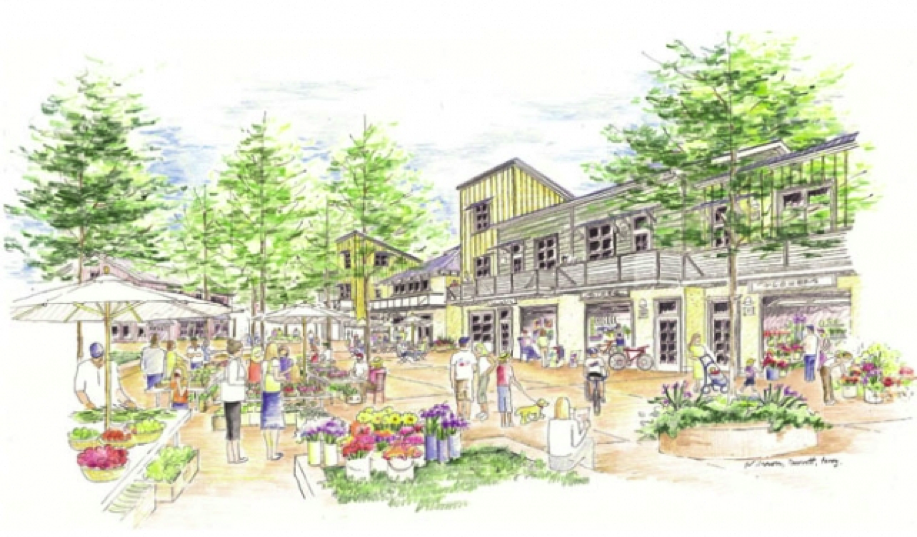
[Editor's note: While this piece is addressed specifically to members of intentional communities, like most of what Laird writes, the reflections and advice here are widely applicable to cooperative projects of all sorts.]
Originally published at Laird's Commentary on Community and Consensus
Looking back over my 50 years of personal experience with intentional community, I have some things to say about the role of common values in communities, about how to think about community buildings (as distinct from private dwellings), and about how the one relates to the other. Let me take them in turn.
I. Common Values
Intentional Communities are called that because residents have purposefully come together around explicit common values. That is, they've made the choice to seek out a life in association with others with whom they share key values. While there can be great variety in what those values are (spiritual, ecological, dietary, parenting philosophy, alignment with certain personal growth disciplines, political agenda, sexual orientation—you name it, and in any combination), the point is that group members agree on those that are the foundation for their life together, and they recruit new members on that basis.
What is often misunderstood about common values, is that they do not eliminate disagreement among members—both because there are any number of ways that members can (and often do) disagree about matters not addressed by the common values, and because different people interpret the same words differently, and those nuances are typically not exposed until you get into the nitty gritty of living together.
So why bother having common values? They are helpful in three main ways:
a) They are the essence of your elevator speech when recruiting new members. You want all new residents to agree to be guided by reasonable interpretations of the group's common values. (If a prospective cannot agree to abide by that, tell them thanks, but no thanks.)
b) Communities do their best work when they regularly identify which common values are in play when wrestling with any given issue, for the purpose of figuring out how best to balance them when choosing how to respond. That's the heavy lifting of plenary considerations, and should generally be well-grounded on a foundation of common values.
c) They also help distinguish what groups are obliged to wrestle with, and what is a member's personal request, that groups are not obliged to honor.
When groups relate to their values in this way—as living, dynamic concepts, rather than as stone tablets handed down by founding fathers & mothers—the community becomes a manifestation of its values, which evolve over time.
With this in mind, I advise groups not to belabor refining their common values at the outset, through a series of what-if thought experiments (how will we handle x, or situation y if either occurs?) Reality will be challenging enough, without worrying about how many angels can be accommodated on a pinhead.
A corollary is understanding that groups effectively refine what their common values mean through the decisions they make. To be sure, the weight that the group gives certain values can (and almost certainly will) change over time—both because there are inevitable shifts in community membership, and because 20-year-olds may value things differently as they become 40-year-olds, and then 60-year-olds, etc.
(Thus, when a long-term member responds to a request to reconsider (or reinterpret) a value with, That's not the way we do things here, it's not particularly helpful. Far better, in my view, is something like, In the past we made the decision to handle this issue as follows… What do you think is different about the current situation that justifies a new approach? See how this both honors what has been done before, yet leaves the door open to making adjustments, in light of new perspectives, or new circumstances?)
Looked at all together, the body of decisions and actions taken by the group over the course of its history becomes an increasingly nuanced statement of what exactly you stand for (or stood for in the past). What's more, you should know that prospective members will be more attracted to what you are, than what you say you intend to be.
II. Community Buildings
Now let's switch gears and consider buildings. While I'm not an architect, I have built some community buildings and been involved in any number of design charrettes. From that experience I want to share some principles about community structures meant to serve the whole. Some are peculiar to the dynamics of community; others are generic to construction in any circumstance.
• While buildings typically last a long time (40+ years), the functions that the community wants that building to serve are likely to change before the building's useful life has been exhausted. Thus, an important design criteria is how easily can you reconfigure how space is used if you change your mind about what you'd like. Example: when Sandhill Farm (my community for four decades) built a major building in 1981, we took this principle to heart by constructing a two-story 25'x48' earth-sheltered building that had no interior load-bearing walls on the lower story. Forty years later, the community has twice completely changed its mind about how to use the bottom half of the building, and it was no big deal to do so either time. Whew.
• Communities' ability to attract and retain members with high-level construction and maintenance skills is hit or miss. Great when you have it; expensive when you don't. Additional caution: while I don't think this is causative, it is relatively common that people who possess blue collar skills such as carpentry, plumbing, electrical work, HVAC expertise, and the like are not necessarily great at soft skills such as communication and relationship repair. Thus, be advised that when you sacrifice the latter to secure the former you are sowing the whirlwind.
• Be cautious about accepting a design for a community building that relies on novel technology or a complicated system to function well. Because membership turnover goes with the territory, what will you do when the "expert" leaves?
• Before signing off on a design feature, ask yourself the question, how will we repair it if it breaks or no longer functions as expected? If you don't have a good answer, think about it some more.
• For things with a relatively short lifespan, the original purchase price is often the most important financial consideration. With durable goods, however—generally defined as things expected to last more than three years—it is prudent to also have a close look at projected maintenance costs. In fact, the longer you expect an item to last, the more important it is to consider maintenance costs. Buildings, of course, are something you expect to be very durable. As such it's generally advisable to use the highest quality materials you can afford, and those which are expected to require the least maintenance, or need replacing least frequently. Example: metal roofing or tiles, rather than shingles.
• Don't limit your thinking solely to indoor space when designing a building; it behooves you to also think outside the box—literally—to include the use of spaces immediately adjacent to the building's thermal envelope, which have the potential to have high utility at low-cost.
Example 1: at Sandhill (in northeastern MO) we had hot humid summers and cold winters. In the winter we'd use our screened-in east-facing porch for firewood storage. For the other three seasons, it was prime social space. It would catch the morning sun when the day was cool—perfect for morning coffee—and be in the shade when the afternoon sun was bearing down, and any breeze was cherished. (As a bonus, it was the ideal spot for processing horseradish in the fall, when the noxious fumes would assault your mucous membranes if attempted indoors.)
Example 2: for minimal cost Sandhill built an unheated expansion to the back porch for the primary purpose of storing canning supplies (obviating the need to schlep boxes in and out of the attic all year). This was a big deal for a community that grew about 80% of its own food, and preserved things in quantity.
III. The Intersection of Common Values & Community Buildings
Years ago, we were having a discussion at Sandhill about the possibility of constructing a new building, when one relatively new member expressed disapproval of how past community buildings were designed, because they didn't adequately take into account permaculture principles.
I recall vividly my response at the time. With a certain amount of irritation, I said the community made decisions about the design of past buildings in exactly the same way we'd approach future ones. To wit, we'd discuss it as a group and combine the best thinking of the current membership to determine the design parameters, giving extra weight to the preferences of the project honcho.
Thus, while I tried to assure the new member that the community would be happy to include his sense of permaculture principles when designing future buildings—so long as he stayed—I was unwilling to feel ashamed that we hadn't anticipated his perspective in the past.
By and large there is nothing that communities do that is a longer lasting statement of how they interpret their values at a certain point in time than its buildings, which often have a lifespan that exceeds that of their constructors. You'll do well to keep that in mind (and remain humble). My advice? Do the best you can with what you have at the time, and expect to get smarter as you go.
What was once a shiny, new state-of-the-art accomplishment can inadvertently slide into the ignominy of becoming a stodgy embarrassment over the course of its lifetime. Oops!

Add new comment